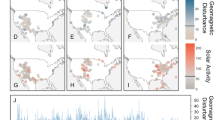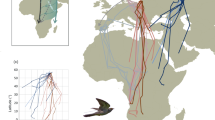Abstract
WHEN young birds leave on their first migration, they are guided by innate information about their direction of migration. It is generally assumed that this direction is represented twice, namely with respect to celestial rotation and with respect to the Earth's magnetic field1,2. The interactions between the two cue systems have been analysed by exposing hand-raised young birds during the premigratory period to cue-conflict situations, in which celestial rotation and the magnetic field provided different information. Celestial rotation altered the course with respect to the magnetic field3–7, whereas conflicting magnetic information did not seem to affect the course with respect to the stars8,9. Celestial information thus seemed to dominate over magnetic information. Here we report that the interaction between the two cue systems is far more complex than this. Celestial rotation alone seems to provide only a tendency to move away from its centre (towards geographical south), which is then modified by information from the magnetic field to establish the distinctive, population-specific migratory direction.
This is a preview of subscription content, access via your institution
Access options
Subscribe to this journal
Receive 51 print issues and online access
$199.00 per year
only $3.90 per issue
Buy this article
- Purchase on Springer Link
- Instant access to full article PDF
Prices may be subject to local taxes which are calculated during checkout
Similar content being viewed by others
References
Wiltschko, R. & Wiltschko, W. Magnetic Orientation in Animals (Springer, Berlin, 1995).
Able, K. P. & Able, M. A. J. Exp. Biol. 199, 3–8 (1996).
Bingman, V. P. Behaviour 87, 43–53 (1983).
Able, K. P. & Able, M. A. Anim. Behav. 39, 905–913 (1990).
Able, K. P. & Able, M. A. Nature 347, 378–379 (1990).
Able, K. P. & Able, M. A. Nature 364, 523–525 (1993).
Prinz, K. & Wiltschko, W. Anim. Behav. 44, 539–545 (1992).
Bingman, V. P. Behaviour 87, 43–53 (1984).
Wiltschko, W., Daum, P., Fergenbauer-Kimmel, A. & Wiltschko, R. Ethology 74, 285–292 (1987).
Zink, G. Der Zug Europäischer Singvögel Vol. 1 (Vogelzug, Möggingen, 1973).
Wiltschko, W. & Gwinner, E. Naturwissenschaften 61, 406 (1974).
Gwinner, E. & Wiltschko, W. J. Comp. Physiol. 125, 267–273 (1978).
Wiltschko, W. & Wiltschko, R. J. Comp. Physiol. 109, 91–99 (1976).
Batschelet, E. Circular Statistics in Biology (Academic, New York, 1981).
Wiltschko, W. & Wiltschko, R. Z. Tierpsychol. 37, 337–355 (1975).
Wiltschko, W. & Wiltschko, R. Z. Tierpsychol. 39, 265–282 (1975).
Bingman, V. P. Auk 104, 523–525 (1987).
Weindler, P. & Wiltschko, W. Verh. Dtsch. Zool. Ges. 84, 369 (1991).
Wiltschko, W. Z. Tierpsychol. 25, 537–558 (1968).
Author information
Authors and Affiliations
Rights and permissions
About this article
Cite this article
Weindler, P., Wiltschko, R. & Wiltschko, W. Magnetic information affects the stellar orientation of young bird migrants. Nature 383, 158–160 (1996). https://doi.org/10.1038/383158a0
Received:
Accepted:
Issue Date:
DOI: https://doi.org/10.1038/383158a0
This article is cited by
-
Why is it so difficult to study magnetic compass orientation in murine rodents?
Journal of Comparative Physiology A (2022)
-
Ten grams and 13,000 km on the wing – route choice in willow warblers Phylloscopus trochilus yakutensis migrating from Far East Russia to East Africa
Movement Ecology (2018)
-
Navigation
Journal of Comparative Physiology A (2017)
-
Further evidence of a time-independent stellar compass in a night-migrating songbird
Behavioral Ecology and Sociobiology (2017)
-
Route simulations, compass mechanisms and long-distance migration flights in birds
Journal of Comparative Physiology A (2017)
Comments
By submitting a comment you agree to abide by our Terms and Community Guidelines. If you find something abusive or that does not comply with our terms or guidelines please flag it as inappropriate.



